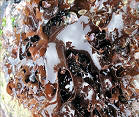Seaweed farming and aquatic plants
Seaweed farming, ALGAPLUS
 ALGAPLUS was created from the will of
two biologists to transfer their scientific knowledge and research experience into a business with impact in the areas of aquaculture, biotechnology and the environment.
ALGAPLUS is the pioneer, in Portugal, of the production
of marine macroalgae (marine vegetables) and its application as the extractive component (biofilter) in integrated multi-trophic aquaculture systems (IMTA).
ALGAPLUS was created from the will of
two biologists to transfer their scientific knowledge and research experience into a business with impact in the areas of aquaculture, biotechnology and the environment.
ALGAPLUS is the pioneer, in Portugal, of the production
of marine macroalgae (marine vegetables) and its application as the extractive component (biofilter) in integrated multi-trophic aquaculture systems (IMTA).
ALGAPLUS sells dried macroalgae, whole or milled (between 1 to 8mm). The species available at the moment are: Gracilaria verrucosa, Chondrus crispus, Ulva lactuca, Porphyra spp., Codium tomentosum. Other species can be considered on customer’s request.
Aquatic plants production South-East Asia
 Aquatic
plants are plants that have adapted to living in aquatic
environments (saltwater or freshwater). They are also referred to as
hydrophytes or macrophytes. A macrophyte is an aquatic plant that
grows in or near water and is either emergent, submergent, or
floating. In lakes and rivers macrophytes provide cover for fish and
substrate for aquatic invertebrates, produce oxygen, and act as food
for some fish and wildlife.
Aquatic
plants are plants that have adapted to living in aquatic
environments (saltwater or freshwater). They are also referred to as
hydrophytes or macrophytes. A macrophyte is an aquatic plant that
grows in or near water and is either emergent, submergent, or
floating. In lakes and rivers macrophytes provide cover for fish and
substrate for aquatic invertebrates, produce oxygen, and act as food
for some fish and wildlife.
Some aquatic plants are used by humans as a food source. Some examples are morning glory or water spinach (Ipomoea aquatica), water mimosa (Neptunia oleracea), water cress (Rorippa nasturtium-aquaticum), water dropwort (Oenanthe stolonifera), water caltrop (Trapa natans), Chinese water chestnut (Eleocharis dulcis) and Indian lotus (Nelumbo nucifera). Some of these edible freshwater aquatic plants are cultivated, sold, and consumed on a huge commercial scale in South-East Asian cities, primarily recycling nutrients from urban waste water. This case study considers the cultivation and marketing of some of 4 aquatic plants in four South-East Asian cities, such as Hanoi, Ho Chi Minh City, Phnom Penh and Bangkok.